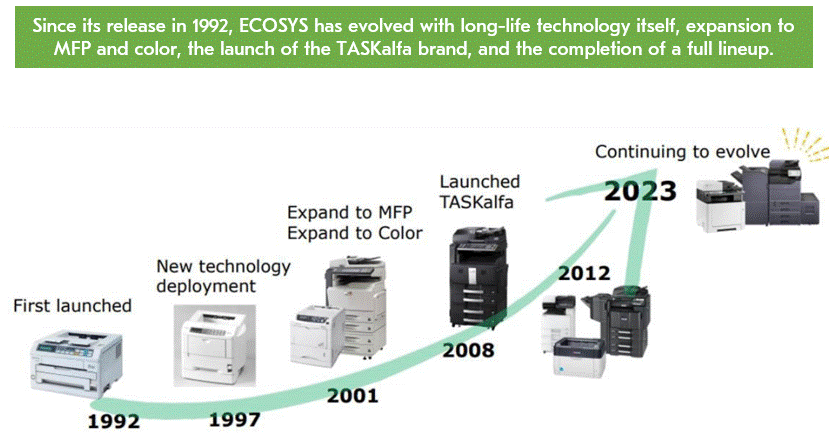Sustainability
Product Development Stage -ECOSYS Concept
ECOSYS Concept
The ECOSYS Concept is Kyocera's unique technology development concept that combines Ecology, which aims to reduce environmental impact by maximizing the lifespan of a printer and MFP(multifunctional products), components and minimizing the replacement and disposal of parts and consumables, with Economy, which provides economic benefits to our customers. It is our goal to achieve both environmental sustainability (Ecology) and economic benefits (Economy) through our proprietary technology development concept, the ECOSYS Concept.
Since the development of the first-generation ECOSYS printer, the "ECOSYS FS-1500," in 1992, we have continuously improved and refined our technology, adapting to changes in the market. Over the past four decades, we have remained committed to our concept. We are currently advancing further developments in long-life technology, aiming for the ultimate Eco=Reduce Zero, where no waste is generated until the end of the printer and MFP's product lifespan. This aligns with Kyocera Document Solutions' concept of embodying the SDGs and achieving carbon neutrality. We will continue to pursue these developments in the future.
● A History of ECOSYS Evolution
Environment-Conscious Design
We employ designs that are environment-conscious from various perspectives for our products, including a long-life design that helps reduce the number of resources used, the frequency of part replacements, and the amount of waste generated, the "3R" design that emphasizes "reduction," "reuse" and "recycling" of components, low power consumption design that helps mitigate emissions of greenhouse gases, and elimination of specific chemical substances which may be contained in products.
Eco-Conscious Design Assessment
We pursue design based on the "Environment-Conscious Design Standards" at each stage from the early development of new products, and working on product development by evaluating whether Environment-Conscious Design is being carried out based on the "Environment-Conscious Design Check List."
These checklists include questions such as "how many components have been reduced and how much has the product weight been lowered compared to previous products," attributes such as "the ease of disassembly and material sorting in the recycling process," and design targets that contribute to curbing the impact on the environment during the processes of manufacturing components and assembling products. Each of these items is numerically quantified and evaluated.
● Evaluation Criteria for Eco-Conscious Design Assessment
- Long-life design
- Design to conserve resources and energy
- 3R design
- Design for easy degradation, separation and classification
- Elimination of hazardous chemical substances
Complying with these standards and specifications and implementing the assessments mentioned above allows us to promote the development of eco-conscious products. And, in addition to product design, we also focus on product packaging and distribution, continuously making eco-conscious efforts in those areas as well.




